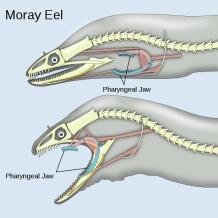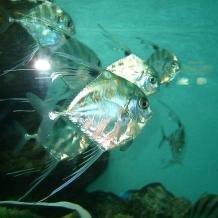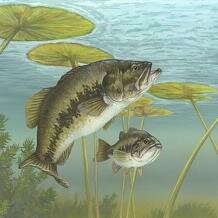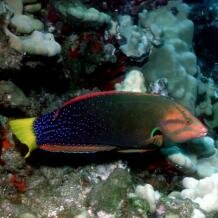Topic: Pharyngeal jaws in teleost fish
One of the great evolutionary breakthroughs in the teleost fish was the conversion of some of the elements that supported the gill bars into a second set of pharyngeal teeth that complemented the oral teeth. See how a fish becomes a snake!
One of the great evolutionary breakthroughs in the teleost fish (and if you see a fish, unless it is a shark or a ray, almost certainly it will be a teleost) was the conversion of some of the elements that supported the gill bars into a second set of pharyngeal teeth that complemented the oral teeth. This led to an enormous versatility of feeding styles, not least because the different teeth could take on different roles.
 In most fishes, the pharyngeal jaws, which are located in the throat, manipulate prey and aid its swallowing. Moray eels, however, cannot create the suction pressures needed for pulling large prey into the oesophagus, probably due to their narrow mouth and elongate body form (which in turn is an adaptation to living in confined coral crevices of shallow reefs). So, as an alternative to the usual hydraulic-based prey transport, moray eels employ their highly mobile pharyngeal jaws.
In most fishes, the pharyngeal jaws, which are located in the throat, manipulate prey and aid its swallowing. Moray eels, however, cannot create the suction pressures needed for pulling large prey into the oesophagus, probably due to their narrow mouth and elongate body form (which in turn is an adaptation to living in confined coral crevices of shallow reefs). So, as an alternative to the usual hydraulic-based prey transport, moray eels employ their highly mobile pharyngeal jaws.  Once they have captured prey in their oral teeth, they protract their raptorial pharyngeal teeth into the oral cavity to grasp the prey and pull it into the oesophagus. This remarkable feeding mechanism is unique to fish, but strikingly reminiscent of the one used by snakes. Just as moray eels transport prey by alternating movements of oral and pharyngeal teeth, snakes use ratcheting movements of the left and right sides of their upper jaws, providing a constant and secure grip on the prey.
Once they have captured prey in their oral teeth, they protract their raptorial pharyngeal teeth into the oral cavity to grasp the prey and pull it into the oesophagus. This remarkable feeding mechanism is unique to fish, but strikingly reminiscent of the one used by snakes. Just as moray eels transport prey by alternating movements of oral and pharyngeal teeth, snakes use ratcheting movements of the left and right sides of their upper jaws, providing a constant and secure grip on the prey.
Apart from this particularly noteworthy example, there are also some more specific convergences related to the evolution of pharyngeal jaws.
Durophagy
 Pharyngeal jaws are put to good use by a number of durophagous teleosts, that is fish that crush hard-shelled prey, such as crabs or mussels. Here, unsurprisingly, the pharyngeal jaws are modified as crushing tooth plates, aided by correspondingly enlarged jaw muscles. This method of feeding has arisen several times independently in the marine realm and is found in the Haemulidae (including the black margate Anisotremus surinamensis), the Sciaenidae (including the black drum Pogonias cromis) and the Carangidae (including the African pompano Alectis ciliaris). Amongst these, the convergences between the last two groups are particularly noticeable. A fourth independent employment of durophagy is found in the freshwater cichlids, notably in the Neotropical heroines, where the ability to crush molluscs may have evolved several times.
Pharyngeal jaws are put to good use by a number of durophagous teleosts, that is fish that crush hard-shelled prey, such as crabs or mussels. Here, unsurprisingly, the pharyngeal jaws are modified as crushing tooth plates, aided by correspondingly enlarged jaw muscles. This method of feeding has arisen several times independently in the marine realm and is found in the Haemulidae (including the black margate Anisotremus surinamensis), the Sciaenidae (including the black drum Pogonias cromis) and the Carangidae (including the African pompano Alectis ciliaris). Amongst these, the convergences between the last two groups are particularly noticeable. A fourth independent employment of durophagy is found in the freshwater cichlids, notably in the Neotropical heroines, where the ability to crush molluscs may have evolved several times.
Centrarchids and cichlids
 An interesting ecomorphological convergence is found between the sunfishes (Centrarchidae), a small family of North American freshwater fishes, and the speciose and diverse cichlids, which occur in freshwaters worldwide. Species in these two families occupy similar ecological niches, have comparable morphologies and even rely on similar feeding mechanics (as characterised by, for example, pressure profiles in the buccal and opercular cavities). While the centrarchid Micropterus salmoides and the cichlid Cichla ocellaris have large mouths, can accelerate rapidly and hunt other fish, the centrarchid Lepomis gibbosus and the cichlid Heros severus are small-mouthed, generally manoeuvrable and prey on benthic invertebrates. These two groups thus represent distinct feeding ecomorphs, which show convergence between the families, supporting the notion that convergence in ecomorphological patterns might be common in fish.
An interesting ecomorphological convergence is found between the sunfishes (Centrarchidae), a small family of North American freshwater fishes, and the speciose and diverse cichlids, which occur in freshwaters worldwide. Species in these two families occupy similar ecological niches, have comparable morphologies and even rely on similar feeding mechanics (as characterised by, for example, pressure profiles in the buccal and opercular cavities). While the centrarchid Micropterus salmoides and the cichlid Cichla ocellaris have large mouths, can accelerate rapidly and hunt other fish, the centrarchid Lepomis gibbosus and the cichlid Heros severus are small-mouthed, generally manoeuvrable and prey on benthic invertebrates. These two groups thus represent distinct feeding ecomorphs, which show convergence between the families, supporting the notion that convergence in ecomorphological patterns might be common in fish.
Labrids
 The wrasses, the marine analogue to cichlids, are a highly diverse group, both in terms of morphology and ecology. They occur very widely, often close to reefs, and have a variety of feeding methods that are reflected in the structure of the jaw and skull. All are very divergent, ranging from the strong “beaks” of parrotfish that emphasise force transmission to the long, slender snout of the bird wrasse (Gomphosus varius) that is specialised for speed, and just what we would expect evolution to produce. However, these local divergences, fascinating as they prove to be, are overprinted in terms of biomechanical arrangement by a set of global convergences. In other words you can invent, metaphorically a whole variety of wheels, but don’t be too surprised if you go to another part of the world to find very much the same set awaiting you. Among the many examples of convergence in labrid feeding modes is the repeated evolution of mechanically fast jaw systems – these have evolved independently at least 14 times.
The wrasses, the marine analogue to cichlids, are a highly diverse group, both in terms of morphology and ecology. They occur very widely, often close to reefs, and have a variety of feeding methods that are reflected in the structure of the jaw and skull. All are very divergent, ranging from the strong “beaks” of parrotfish that emphasise force transmission to the long, slender snout of the bird wrasse (Gomphosus varius) that is specialised for speed, and just what we would expect evolution to produce. However, these local divergences, fascinating as they prove to be, are overprinted in terms of biomechanical arrangement by a set of global convergences. In other words you can invent, metaphorically a whole variety of wheels, but don’t be too surprised if you go to another part of the world to find very much the same set awaiting you. Among the many examples of convergence in labrid feeding modes is the repeated evolution of mechanically fast jaw systems – these have evolved independently at least 14 times.
Cite this web page
Map of Life - "Pharyngeal jaws in teleost fish"
https://mapoflife.org/topics/topic_361_pharyngeal-jaws-in-teleost-fish/
March 4, 2021

